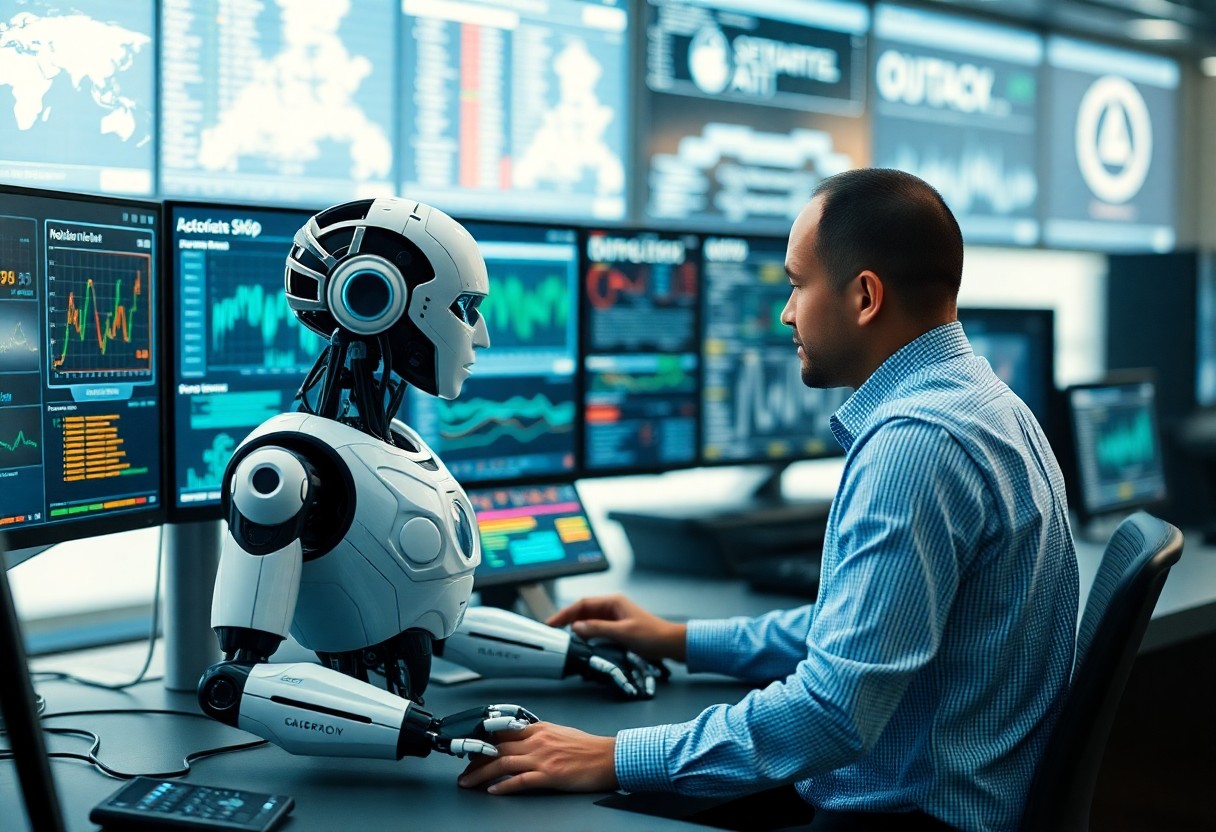Training Robots For Better Human-Robot Collaboration
10 Kitchen Hacks To Simplify Your Healthy Cooking Routine
March 18, 2025Smart Cooking Tips For Perfectly Balanced Meals Every Time
March 19, 2025Training robots effectively is necessary for enhancing human-robot collaboration, ultimately leading to safer and more efficient work environments. By focusing on communication skills and developing adaptive behaviors, you can ensure that robots respond to human actions in ways that are intuitive and beneficial. Understanding the intricacies of this training process will allow you to leverage the full potential of robotic partners, paving the way for innovations that improve productivity while simultaneously minimizing risks associated with automation. Equip yourself with the knowledge to foster a harmonious and efficient collaboration.

Importance of Human-Robot Collaboration
For successful integration of robots into your work environment, human-robot collaboration is imperative. This synergy not only enhances efficiency and productivity but also optimizes workflows, enabling you to focus on higher-value tasks. By working alongside robots, you can leverage their strengths while maintaining the human touch that is irreplaceable in many industries.
Enhanced Productivity
Beside increasing output, effective human-robot collaboration optimizes resource allocation, leading to significant operational gains. When robots handle repetitive tasks, you can dedicate time and effort to more complex projects, ultimately driving innovation and improving your team’s overall performance.
Safety Considerations
Across various industries, ensuring workplace safety in human-robot collaboration is paramount. Integrating safety protocols not only protects you and your colleagues but also enhances the overall efficiency of robotic systems.
But while robots are designed to assist, challenges persist, especially in their interaction with human workers. Maintaining a safe work environment involves implementing regulations and guidelines that minimize risks, such as ensuring proper training for all personnel and employing safety sensors in robots. By prioritizing monitoring systems and enhancing communication, you can mitigate hazards, fostering a more secure setting. Bolstering safety standards allows robots to function effectively while ensuring that you and your team feel safe and confident in your collaborative efforts.
Key Challenges in Human-Robot Collaboration
If you are engaging in human-robot collaboration, understanding the key challenges involved is vital to ensure effective teamwork. These challenges can range from technical limitations to social dynamics that may affect interaction and efficiency in collaborative tasks.
Communication Barriers
Below are some common communication barriers that can hinder effective collaboration. Robots often have difficulty interpreting natural language, gestures, and social cues, which can lead to misunderstandings. Moreover, the lack of a shared vocabulary can limit the efficiency of your interactions, making it necessary to create a common ground for communication between you and the robot.
Trust Issues
About establishing a solid partnership with robots, trust issues often arise when you lack confidence in their reliability and decision-making capabilities. If a robot exhibits unexpected behavior or malfunctions, it can undermine your willingness to collaborate effectively.
Also, building trust in human-robot collaboration requires a consistent demonstration of the robot’s functionality and reliability. You need to navigate potential concerns about safety and predictability, as any unexpected actions by the robot can lead to hesitation in your collaboration. Furthermore, establishing a positive relationship can be hindered by your skepticism; thus, it’s necessary for the robot to show transparency in its processes and decision-making. The more comfortable and assured you feel, the better the outcomes of your collaborative efforts will be.
Training Methods for Robots
Clearly, the evolution of Learning Diverse Strategies for Human-Robot Collaboration has introduced various training methods for robots, allowing them to better understand and adapt to human interactions. Integrating methods such as simulation-based training and real-world learning approaches enhances the ability of robots to collaborate effectively with humans, leading to improved outcomes in shared environments.
Simulation-Based Training
Training robots using simulation-based approaches allows you to create a controlled environment where they can learn to interact with humans without the risks associated with real-world testing. This method offers flexibility to experiment with different scenarios, enabling robots to develop skills that enhance their collaboration abilities.
Real-World Learning Approaches
Above all, real-world learning approaches involve your robots interacting in actual environments, providing them with the opportunity to encounter real-time challenges and unpredictability. This type of learning is crucial for improving robot adaptability and responsiveness to human actions and intentions.
And by engaging in real-world learning, robots receive important, valuable insights from genuine interactions. This approach helps highlight potential hazards they may encounter, ensuring they can safely navigate complex environments. Furthermore, the feedback learned from dealing with dynamic situations enhances their performance, leading to more reliable and effective collaborations with humans over time. Ultimately, these real-world experiences foster a better understanding of human behaviors and preferences, paving the way for successful partnerships.
The Role of AI in Training
Keep in mind that artificial intelligence (AI) plays a vital role in enhancing human-robot collaboration by optimizing training processes. By leveraging AI algorithms, you can develop training protocols that adapt to individual robot capabilities and human operator preferences. This ultimately leads to improved collaboration, efficiency, and safety in shared work environments.
Machine Learning Techniques
Among the various strategies used in AI training, machine learning techniques stand out. These techniques enable robots to learn from data and experiences, allowing you to fine-tune their performance in real-world scenarios. By harnessing machine learning, you can ensure that robots continuously improve over time, making them more effective partners in your tasks.
Adaptive Learning Systems
Among innovative approaches to robot training, adaptive learning systems are becoming increasingly popular. These systems enable you to personalize training based on real-time feedback, ensuring that both robots and humans adapt to each other’s needs effectively.
It is imperative for you to explore the benefits of adaptive learning systems in robot training. These systems utilize dynamic feedback to adjust to the operational environment and your specific preferences, fostering a more collaborative workspace. By employing adaptive learning, you can create robots that respond to changing situations and human behaviors—this adaptability enhances safety and productivity. As a result, training becomes a cooperative process, leading to a more harmonious interaction between robots and humans.
Case Studies in Effective Collaboration
To illustrate the potential of effective human-robot collaboration, here are some compelling case studies:
- Automotive Manufacturing: A leading car manufacturer reported a 25% increase in production speed by integrating collaborative robots (cobots) on the assembly line.
- Warehousing: An e-commerce giant improved order fulfillment efficiency by 30% through the use of automated picking robots working alongside staff.
- Agricultural Robotics: A smart farming startup achieved a 40% reduction in labor costs by deploying robotic systems for planting and harvesting.
Manufacturing Sector
Between innovative technologies and skilled employees, the manufacturing sector has transformed significantly. Factories that embrace collaborative robotics experience not only enhanced operational efficiency but also a drop in workplace accidents. The use of cobots allows you to enhance productivity without compromising safety.
Healthcare Applications
Before the integration of robotics, many healthcare facilities faced challenges such as labor shortages and high workload. The introduction of robots to assist in surgeries and patient care made a profound difference.
With the application of robot-assisted surgeries, hospitals have reported a 20% decrease in recovery times for patients. Moreover, robotic exoskeletons empower individuals with mobility impairments, aiding their rehabilitation. In emergency scenarios, drones deliver critical medical supplies, reducing crucial wait times. This synergy between you and robotic technology not only enhances patient outcomes but also significantly alleviates staff burdens. The dynamic collaboration captures the essence of efficiency and improved care in healthcare environments.
Future Trends in Human-Robot Collaboration
After examining current practices, it is clear that the future of human-robot collaboration promises enhanced synergy through improved communication, adaptability, and efficiency. As robots become more intelligent and responsive, you can expect them to seamlessly integrate into various work environments, optimizing tasks and augmenting human capabilities. This era will likely focus on building more intuitive interfaces and enhancing emotional intelligence in robots to foster better teamwork.
Advances in Robotics Technology
Against traditional automation methods, recent advances in robotics technology are enabling more sophisticated interactions between humans and robots. Innovations in artificial intelligence, machine learning, and sensor technologies allow robots to better understand your needs, respond to your actions, and even predict your preferences. This evolution is paving the way for personalized assistance and increased productivity across industries.
Evolving Human Roles
For you, the evolving roles of humans in a collaborative environment signifies a shift from routine tasks to more strategic and creative responsibilities. As robots take over repetitive functions, your focus will shift towards supervisory roles, decision-making, and innovation, allowing you to harness your unique human qualities in the workplace.
It is crucial for you to recognize that this transition offers various opportunities for growth and enhancement of skills. By embracing the shift towards strategic interactions, you will not only enhance your adaptability but also cultivate a work atmosphere where you can leverage creativity and critical thinking. Furthermore, this evolution means that human input will become even more valuable, leading to a synergistic partnership where robots and people work together to achieve greater efficiency and innovation in problem-solving.
To wrap up
Considering all points, enhancing human-robot collaboration through effective training is vital for maximizing productivity and safety in various environments. By understanding the interactions and behaviors expected from both you and robots, you can create a more harmonious working relationship. Investing in appropriate training methods will not only improve efficiency but also foster trust, allowing both parties to achieve their potential. Embracing this innovative approach will be key for your future endeavors in integrating robots into your workflow.
NEWSLETTER






